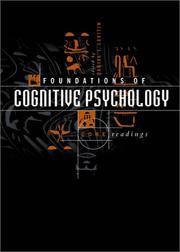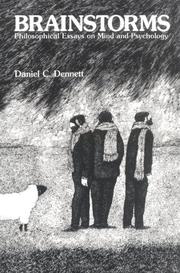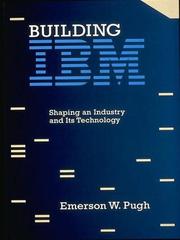| Listing 1 - 10 of 313 | << page >> |
Sort by
|
Book
Year: 1996 Publisher: Cambridge, Massachusetts : [Piscataqay, New Jersey] : MIT Press, IEEE Xplore,
Abstract | Keywords | Export | Availability | Bookmark
 Loading...
Loading...Choose an application
- Reference Manager
- EndNote
- RefWorks (Direct export to RefWorks)
Although Inductive Logic Programming (ILP) is generally thought of as a research area at the intersection of machine learning and computational logic, Bergadano and Gunetti propose that most of the research in ILP has in fact come from machine learning, particularly in the evolution of inductive reasoning from pattern recognition, through initial approaches to symbolic machine learning, to recent techniques for learning relational concepts. In this book they provide an extended, up-to-date survey of ILP, emphasizing methods and systems suitable for software engineering applications, including inductive program development, testing, and maintenance.Inductive Logic Programming includes a definition of the basic ILP problem and its variations (incremental, with queries, for multiple predicates and predicate invention capabilities), a description of bottom-up operators and techniques (such as least general generalization, inverse resolution, and inverse implication), an analysis of top-down methods (mainly MIS and FOIL-like systems), and a survey of methods and languages for specifying inductive bias Logic Programming series.
Book
ISBN: 0262339412 0262339404 Year: 2017 Publisher: Cambridge, MA : The MIT Press,
Abstract | Keywords | Export | Availability | Bookmark
 Loading...
Loading...Choose an application
- Reference Manager
- EndNote
- RefWorks (Direct export to RefWorks)
"This book presents an integration of recent research that reveals the knowledge and reasoning of expert weather forecasters, explaining how they understand and predict the weather. The book also discusses different styles and approaches to forecasting. It summarizes what weather forecasters themselves have said about their reasoning, the literature of what makes for sound training of forecasters, studies of forecast accuracy, attempts to generate computer systems to forecast weather, and the technologies used in forecasting (including displays and visualizations) in such systems as radar and satellite. It presents a case study in which forecasters at a facility were probed for their reasoning and a proficiency scale was developed. In addition, the book summarizes and integrates the newest cutting-edge research in applied cognitive science, human factors engineering, cognitive systems engineering, and human-computer interaction that has investigated aspects of the psychology of weather forecasting, including knowledge and mental models, perceptual and display interpretation skills, and reasoning heuristics and strategies"--Provided by publisher.
Weather forecasting. --- PHYSICAL SCIENCES/General --- COGNITIVE SCIENCES/General

ISBN: 0262122472 0262621592 9786612099823 1282099825 026227826X 0585446539 9780262278263 9780585446530 9780262122474 9780262621595 Year: 2002 Publisher: Cambridge (Mass.) : MIT press,
Abstract | Keywords | Export | Availability | Bookmark
 Loading...
Loading...Choose an application
- Reference Manager
- EndNote
- RefWorks (Direct export to RefWorks)
Scientists from many disciplines, including physics, chemistry, biology, and neuroscience, contribute to the study of cognition. Cognitive psychology, the science of the human mind and of how people process information, is at the core of empirical investigations into the nature of mind and thought. This anthology is based on the assumption that cognitive psychology is at heart empirical philosophy. Many of the core questions about thought, language, perception, memory, and knowledge of other people's minds were for centuries the domain of philosophy. The book begins with the philosophical foundations of inquiry into the nature of mind and thought, in particular the writings of Descartes, and then covers the principal topics of cognitive psychology including memory, attention, and decision making. The book organizes a daunting amount of information, underlining the essentials, while also introducing readers to the ambiguities and controversies of research. It is arranged thematically and includes many topics not typically taught in cognition courses, including human factors and ergonomics, evolutionary psychology, music cognition, and experimental design. The contributors include Daniel Dennett, Daniel Kahneman, Jay McClelland, Donald Norman, Michael Posner, Stephen Palmer, Eleanor Rosch, John Searle, Roger Shepard, and Anne Treisman.
Book
ISBN: 0262027992 1322151385 0262325446 9780262325448 9781322151380 9780262027991 Year: 2014 Publisher: Cambridge, Massachusetts London, England
Abstract | Keywords | Export | Availability | Bookmark
 Loading...
Loading...Choose an application
- Reference Manager
- EndNote
- RefWorks (Direct export to RefWorks)
A novel proposal that the unified nature of our cognition can be partially explained by a cognitive architecture based on graphical models.
PSYCHOLOGY --- Neuropsychology --- Cognition --- Social Sciences --- Psychology --- Cognition. --- COGNITIVE SCIENCES/General --- PHILOSOPHY/Philosophy of Mind/General

ISBN: 0262540371 0262040646 0262271508 0585316007 9780262271509 9780262040648 9780262540377 Year: 1998 Publisher: Cambridge (Mass.) : MIT press,
Abstract | Keywords | Export | Availability | Bookmark
 Loading...
Loading...Choose an application
- Reference Manager
- EndNote
- RefWorks (Direct export to RefWorks)
This collection of 17 essays by the author offers a comprehensive theory of mind, encompassing traditional issues of consciousness and free will. Using careful arguments and ingenious thought-experiments, the author exposes familiar preconceptions and hobbling institutions.This collection of 17 essays by the author offers a comprehensive theory of mind, encompassing traditional issues of consciousness and free will. Using careful arguments and ingenious thought-experiments, the author exposes familiar preconceptions and hobbling institutions. The essays are grouped into four sections: Intentional Explanation and Attributions of Mentality; The Nature of Theory in Psychology; Objects of Consciousness and the Nature of Experience; and Free Will and Personhood.
Psychology --- Philosophy. --- Cognition. --- COGNITIVE SCIENCES/General --- PHILOSOPHY/General --- Mental philosophy --- Humanities
Book
ISBN: 0262036193 0262340097 9780262340090 9780262036191 0262340100 Year: 2017 Publisher: Cambridge, Massachusetts : The MIT Press,
Abstract | Keywords | Export | Availability | Bookmark
 Loading...
Loading...Choose an application
- Reference Manager
- EndNote
- RefWorks (Direct export to RefWorks)
Pithy, direct, and bold: essays that propose new ways to think about old problems, spanning a range of philosophical topics.
Philosophy. --- PHILOSOPHY/General --- COGNITIVE SCIENCES/General --- LINGUISTICS & LANGUAGE/General --- Mental philosophy --- Humanities

ISBN: 9780262281942 0585353468 9780585353463 0262281945 9780262512824 0262161478 9780262161473 Year: 1995 Publisher: Cambridge (Mass.) The MIT Press
Abstract | Keywords | Export | Availability | Bookmark
 Loading...
Loading...Choose an application
- Reference Manager
- EndNote
- RefWorks (Direct export to RefWorks)
No company of the twentieth century achieved greater success and engendered more admiration, respect, envy, fear, and hatred than IBM. Building IBM tells the story of that company, how it was formed, how it grew, and how it shaped and dominated the information processing industry. Emerson Pugh presents substantial new material about the company in the period before 1945 as well as a new interpretation of the postwar era. Granted unrestricted access to IBM's archival records and with no constraints on the way he chose to treat the information they contained, Pugh dispels many widely held myths about IBM and its leaders and provides new insights on the origins and development of the computer industry. Pugh begins the story with Herman Hollerith's invention of punched-card machines used for tabulating the U.S. Census of 1890, showing how Hollerith's inventions and the business he established provided the primary basis for IBM. He tells why Hollerith merged his company in 1911 with two other companies to create the Computing-Tabulating-Recording Company, which changed its name in 1924 to International Business Machines. Thomas J. Watson, who was hired in 1914 to manage the merged companies, exhibited remarkable technological insight and leadership, in addition to his widely heralded salesmanship, to build Hollerith's business into a virtual monopoly of the rapidly growing punched-card equipment business. The fascinating inside story of the transfer of authority from the senior Watson to his older son, Thomas J. Watson Jr., and the company's rapid domination of the computer industry occupy the latter half of the book. In two final chapters, Pugh examines conditions and events of the 1970s and 1980s and identifies the underlying causes of the severe probems IBM experienced in the 1990s. - Publisher.
Computer industry --- Informatique --- History --- Industrie --- Histoire --- International Business Machines Corporation --- IBM --- History. --- COGNITIVE SCIENCES/General
Book
ISBN: 0262337266 0262337258 026203560X Year: 2017 Publisher: Cambridge, Massachusetts ; London, England : The MIT Press,
Abstract | Keywords | Export | Availability | Bookmark
 Loading...
Loading...Choose an application
- Reference Manager
- EndNote
- RefWorks (Direct export to RefWorks)
An argument that moral reasoning plays a crucial role in moral judgment through episodes of rational reflection that have established patterns for automatic judgment foundation.Rationalists about the psychology of moral judgment argue that moral cognition has a rational foundation. Recent challenges to this account, based on findings in the empirical psychology of moral judgment, contend that moral thinking has no rational basis. In this book, Hanno Sauer argues that moral reasoning does play a role in moral judgment--but not, as is commonly supposed, because conscious reasoning produces moral judgments directly. Moral reasoning figures in the acquisition, formation, maintenance, and reflective correction of moral intuitions. Sauer proposes that when we make moral judgments we draw on a stable repertoire of intuitions about what is morally acceptable, which we have acquired over the course of our moral education--episodes of rational reflection that have established patterns for automatic judgment foundation. Moral judgments are educated and rationally amenable moral intuitions. Sauer engages extensively with the empirical evidence on the psychology of moral judgment and argues that it can be shown empirically that reasoning plays a crucial role in moral judgment. He offers detailed counterarguments to the anti-rationalist challenge (the claim that reason and reasoning play no significant part in morality and moral judgment) and the emotionist challenge (the argument for the emotional basis of moral judgment). Finally, he uses Joshua Greene's Dual Process model of moral cognition to test the empirical viability and normative persuasiveness of his account of educated intuitions. Sauer shows that moral judgments can be automatic, emotional, intuitive, and rational at the same time.
Judgment (Ethics) --- Ethics --- Emotions. --- Ethical intuitionism. --- Psychological aspects. --- PHILOSOPHY/General --- COGNITIVE SCIENCES/General
Book
ISBN: 0262343703 026234369X Year: 2017 Publisher: Cambridge, Massachusetts : The MIT Press,
Abstract | Keywords | Export | Availability | Bookmark
 Loading...
Loading...Choose an application
- Reference Manager
- EndNote
- RefWorks (Direct export to RefWorks)
"We start with a simple question: If you could reinvent higher education for the 21st century, what should it look like? We began by taking a hard look at problems in traditional higher education, and innovated in many ways to address these problems head-on: We have created a new curriculum, focusing on what we call "practical knowledge"; we have developed new pedagogy, based on the science of learning; we have used technology in novel ways, to deliver small seminars in real time; and we have developed an international hybrid residential model, where students take classes on the computer but live together, rotating through seven different cities around the world. The Minerva Schools at the Keck Graduate Institute (KGI) are the first university experience built for the twenty-first century. In setting up this program, we have had to confront the realities of all aspects of higher education--from admissions, through instruction, to career development, to establishing a reputation. The goal of this book is to provide an evidence-based model for a future of higher education. We have learned a lot about how to reshape all facets of higher education and this book summarizes what we have learned. We hope that our innovations can serve as models of "best practices"--And thereby have a major influence on higher education writ large"--
Education, Higher --- Aims and objectives. --- Philosophy. --- Curricula --- EDUCATION/General --- COGNITIVE SCIENCES/General
Book
ISBN: 0262284057 1423733355 Year: 2003 Publisher: Cambridge, Mass. : MIT Press,
Abstract | Keywords | Export | Availability | Bookmark
 Loading...
Loading...Choose an application
- Reference Manager
- EndNote
- RefWorks (Direct export to RefWorks)
How did the human brain evolve so that consciousness of art could develop? In The Psychology of Art and the Evolution of the Conscious Brain, Robert Solso describes how a consciousness that evolved for other purposes perceives and creates art. Drawing on his earlier book Cognition and the Visual Arts and ten years of new findings in cognitive research (as well as new ideas in anthropology and art history), Solso shows that consciousness developed gradually, with distinct components that evolved over time. One of these components is an adaptive consciousness that includes the ability to imagine objects that are not present--an ability that allows us to create (and perceive) visual art. Solso describes the neurological, perceptual, and cognitive sequence that occurs when we view art, and the often inexpressible effect that a work of art has on us. He shows that there are two aspects to viewing art: nativistic perception--the synchronicity of eye and brain that transforms electromagnetic energy into neuro-chemical codes--which is "hard-wired" into the sensory-cognitive system; and directed perception, which incorporates personal history and knowledge--the entire set of our expectations and past experiences. Both forms of perception are part of the appreciation of art, and both are products of the evolution of the conscious brain over hundreds of thousands of years.Solso also investigates the related issues of neurological and artistic perception of the human face, the effects of visual illusions, and the use of perspective. The many works of art used as examples are drawn from a wide range of artistic traditions, from ancient Egypt to Africa and India and the European Renaissance.
Consciousness. --- Cognition. --- Brain --- Visual perception. --- Art --- Evolution. --- Psychology. --- COGNITIVE SCIENCES/General --- ARTS/General
| Listing 1 - 10 of 313 | << page >> |
Sort by
|

 Search
Search Feedback
Feedback About UniCat
About UniCat  Help
Help News
News